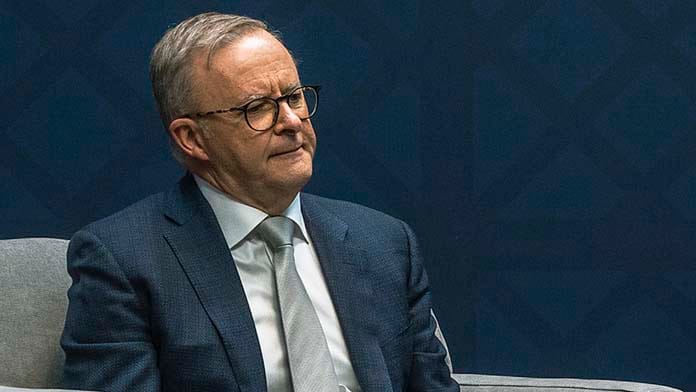Labor’s new climate policy is nowhere near what’s needed to stop dangerous climate change. Although it promises tens of thousands of jobs, it does nothing to guarantee they will be well paid, or where they are needed. And with Labor still backing the Liberals’ plan to massively expand gas and fossil fuel extraction, it locks in climate catastrophe.
Labor’s new target is lower than what it took to the last election, and lower than even what the Business Council of Australia (BCA) wants. It has opted for a 43 per cent reduction target by 2030, when the BCA backs 50 per cent. This puts in stark relief how weak it is.
Climate change is already causing havoc worldwide. Only rapid and dramatic changes can avoid dangerous levels of heating. Once the world passes tipping points like ice shelf collapse, runaway warming will be unstoppable. But Labor’s target would not even put us on track for net zero emissions by 2050, the stated aim of the global agreements on climate.
Rich nations like Australia need to get to zero far more quickly if the world has any hope of meeting this target. The Climate Council says Australia needs to cut emissions by 75 per cent by 2030. Labor is not even going to get close to that.
Instead of aiming for what’s needed to save the planet, Labor leader Anthony Albanese was falling over himself to say his policy was “what business wants”. And business agreed, with the BCA calling the policy “sensible and workable” and the Chamber of Commerce and Industry lauding it as “encouraging to see” and “a sensible approach”.
But it is Australian companies’ desire to keep profiting out of fossil fuels for as long as possible that has put us on track for climate disaster.
Climate jobs
Labor’s plan does show the potential for jobs from a serious climate transition. It estimates there would be 130,000 new jobs in constructing transmission infrastructure and solar and wind farms, and all up an additional 604,000 jobs by 2030. Power prices would actually drop by 26 per cent.
Predictably, Scott Morrison tried to spread fear that Labor’s policy would mean “forcing people out of jobs”. This echoes the successful campaign the Liberals and Nationals ran at the last election in coal mining areas like central Queensland and NSW’s Hunter region.
The problem is, Labor’s plan does not do enough to guarantee high wage jobs with good conditions. It is leaving it to big companies to build all the new renewable energy generation and deliver most of its changes.
This risks a race to the bottom on wages and conditions in the power sector. Many of the existing solar farms across Australia have an appalling record on wages and safety standards.
The jobs in Labor’s plan look good on paper. But this is not enough to convince workers in coal and gas industries, who have seen how workers get left behind when big companies close down. Winning them over requires a much clearer guarantee from government that they will have good jobs in the new industries.
Guaranteeing good jobs, in the places where they are needed to replace jobs in coal and gas, requires new public sector jobs. It was government that built the existing coal power stations, and government could easily invest to build renewable energy to replace them.
Poles and wires
The only significant public investment Labor is planning is in electricity poles and wires, through upgrades to the electricity grid. These will be necessary to handle the shift to renewable sources of power. And even here Labor wants partial privatisation where business would pay for part of the cost.
They also propose a National Reconstruction Fund, but it would spend only $3 billion over eight years, or less than $400 million a year.
Labor’s key measures are around power generation, electric cars and industry emissions. There will be a small increase in renewable energy, which is set to get to 68 per cent of our power needs by 2030 anyway, with Labor boosting this to 82 per cent.
Polluting industries will have to reduce their emissions, through an extension of the Liberals’ existing Safeguards Mechanism. This, too, has been welcomed by the BCA. That’s no surprise, because Labor would allow companies to buy offsets instead of actually reducing their emissions.
There are also measures to boost uptake of electric vehicles, with the hope that they will make up 15 per cent of all cars on the road by 2030.
But even while Labor is proposing measures to reduce emissions, it is backing the Liberals’ plans to expand gas drilling and export. On 29 November, it voted through another $50 million to speed up gas mining in the Beetaloo Basin in the NT. There are estimates this one basin alone could push Australia’s emissions up by 20 per cent a year.
Just one project recently finalised in WA, Woodside’s Scarborough LNG project, would add another 2 per cent to the country’s annual emissions alone. These figures don’t include the emissions when the gas is finally burnt for use overseas. And there are also plans for more gas fracking in NSW’s Narrabri, WA’s Kimberley region, Queensland’s Bowen and Galilee Basins and others.
Labor’s resources spokesperson, Madeleine King, has also backed continued coal exports even beyond 2050, despite the party’s net zero emissions pledge.
Kicking out Scott Morrison will be a step forward for climate action. But it’s also clear Labor is not willing to take the action that’s needed.
The climate movement needs to stay on the streets in the lead up to the election to help drive the Liberals out. But electing Labor won’t be the end of the fight.
By James Supple






